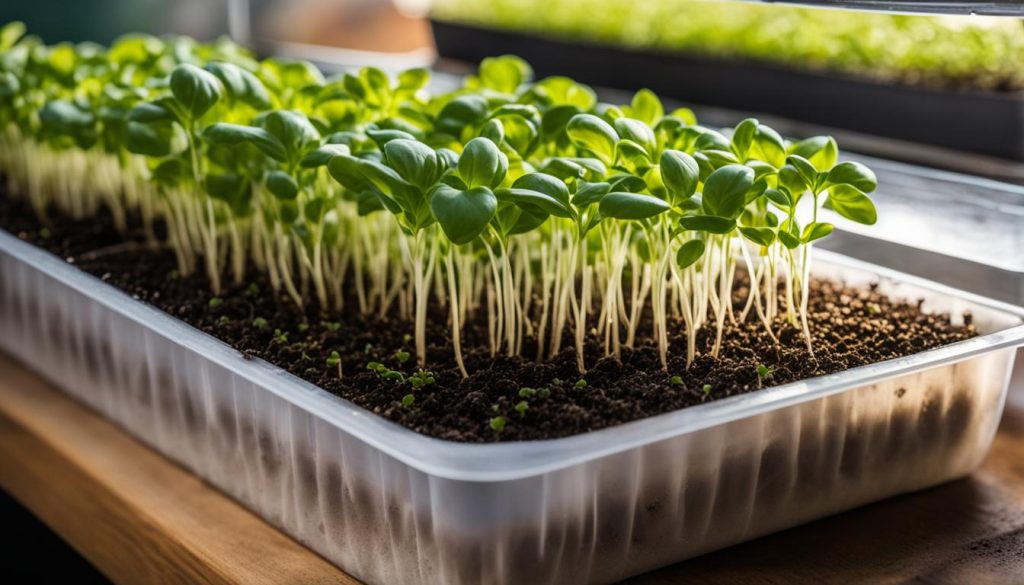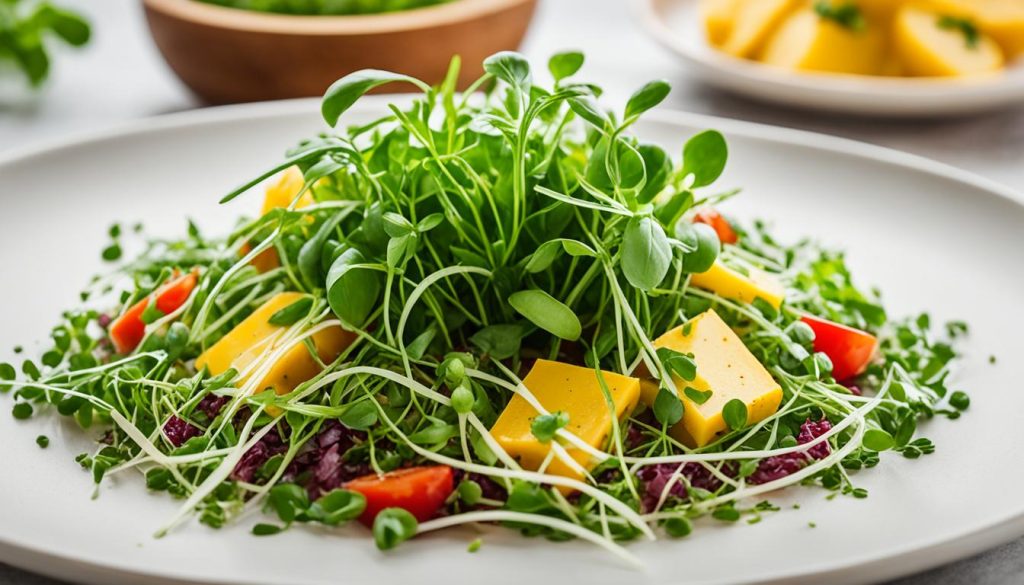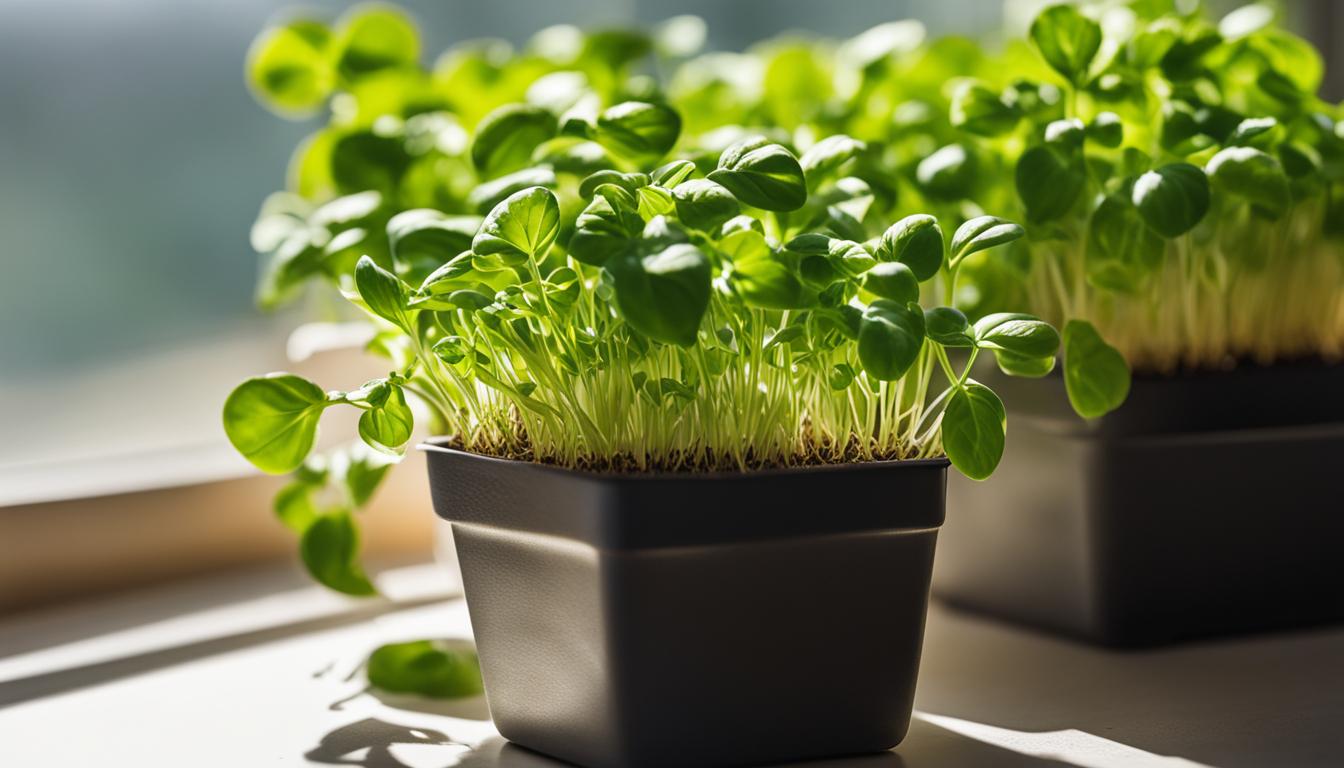Embark on a green-thumbed journey to nurture your very own fresh basil microgreens, a powerhouse of flavor and nutrition, right from the comfort of your home. This handy guide serves as the perfect starting point for those wondering how to grow basil microgreens, offering step-by-step insights into the process of turning tiny seeds into fragrant, flavorful greens bursting with vitality. Not only will you gain the satisfaction of watching your garden thrive, but you’ll also be fortifying your meals with basil microgreens nutrition—an impressive array of vitamins and minerals with each delicious bite.
Gather your seeds and let your culinary adventure begin, as we guide you through the secrets to growing an aromatic bounty that will elevate your home cooking to new heights of healthfulness and taste.
The Fascinating History and Benefits of Basil Microgreens
Basil microgreens are more than just a culinary delight; these tiny, aromatic greens harbor a history as rich as their flavor. Cultivated for their distinctive taste and nutritional density, organic basil microgreens are a testament to the enduring legacy of basil as a cherished herb.
Understanding Basil Microgreens
On the windowsills of chefs and the plates of health enthusiasts, basil microgreens have risen as a powerhouse of concentrated nutrients and taste. They represent the youthful stages of basil, harvested just after the seed leaves, also known as cotyledons, have fully developed and the true leaves begin to emerge.
History of Basil Usage Through Time
Basil’s journey through time has been marked with reverence and utility. This cherished herb has perfumed world histories, touching ancient societies with its medicinal qualities and gracing royal cuisines with its unique taste. The cultivation of basil microgreens nutrition today is a modern reflection of this herb’s timeless appeal.
Health Benefits of Basil Microgreens
The virtues of basil microgreens extend beyond their culinary use. They are esteemed for their ability to support immune function, enhance ocular health, foster skin repair, and bolster muscle maintenance. This makes integrating organic basil microgreens into your diet not only a treat for the palate but also a boon for wellness.
Nutritional Power of Basil Microgreens
With a host of essential vitamins and minerals, the nutritional profile of basil microgreens is impressive. These greens are notably rich in Vitamins A, C, and E, and contain a wealth of minerals like calcium and iron, offering substantial benefits of basil microgreens that underscore their value in any health-conscious kitchen.
Preparing to Grow Basil Microgreens at Home
Embarking on the journey of growing basil microgreens in the comfort of your home is both exciting and rewarding. Before diving into planting, it’s essential to have a firm grasp on the process and to gather the right supplies to ensure your success.
Selecting the Perfect Basil Microgreens Variety
Selection of seeds is the first critical step in your microgreen gardening adventure. When determining where to buy basil microgreens, look for reputable seed suppliers offering high-quality, non-GMO options. Choose a variety that caters to your flavor preferences and culinary needs, ensuring it is suitable for microgreen cultivation.
Essential Supplies for Growing Basil Microgreens
Gather your gardening toolkit, which should include a shallow tray designed for microgreens that retains water effectively. Pair it with a high-quality potting mix primed for the seedlings’ delicate roots. Adequate lighting is paramount, and selecting a reliable LED or fluorescent grow light will sustain your plants’ growth. Arm yourself with a sharp knife for a clean harvest, a humidity dome to control the environment, a spray bottle for gentle watering, and an organic fertilizer to provide balanced nutrients. By securing these essentials, you’ll be well on your way to mastering how to grow basil microgreens and enjoying a burst of freshness in your dishes.
Step-by-Step Guide to Growing Basil Microgreens
Embarking on the journey of growing basil microgreens is both a joy and a fantastic learning curve for garden enthusiasts and culinary artists alike. To experience the rewards of the basil microgreens nutrition and the satisfaction of cultivating your own lush greens, follow this friendly, step-by-step guide tailored for beginners and seasoned gardeners.
**Step 1: Seed Sowing** – Start with a sterile, moistened seed starting mix in a shallow tray. Scatter the basil seeds uniformly to avoid clumping, ensuring each tiny green has ample space to grow. The high-quality seeds promise strong plants rich in nutrients, setting the foundation for excellent basil microgreens nutrition. This is the critical first step in how to grow basil microgreens.
**Step 2: Germination Environment** – After sowing, simulate the ideal conditions for seed germination by covering the tray with a humidity dome or a second tray. This creates a micro-environment that maintains moisture and encourages the seeds to sprout. It won’t take long before you see the first signs of life in your personal mini basil greenhouse and this promising sight is your sure sign that the journey to growing basil microgreens at home is well underway.
**Step 3: Light and Water** – When the first sprouts push through the soil, remove the dome to let them breathe and introduce them to light. Use a fine mist to keep the soil moist but not waterlogged, striking the balance that these delicate plants need to thrive. Consistently give them light, be it natural or artificial, to ensure they photosynthesize and develop into strong, flavorful microgreens.
Following these steps, your patience and attention to detail will pay off when you reach the most exciting stage: harvesting your very own basil microgreens. In a few short weeks, you will have transformed seeds into a vibrant, edible tapestry of green, ready to enhance your dishes with the freshest flavors imaginable.
Optimal Environmental Conditions for Basil Microgreens Growth
Creating the ideal growing conditions for basil microgreens is essential in nurturing these delicate plants to full vibrancy. Ensuring a steady temperature between 60-70°F will closely replicate their preferred natural environment. This careful temperature management prevents undue plant stress, which is important as stress can lead to premature bolting—where the plant goes to seed too early, negatively affecting both the yield and flavor of your basil microgreens microgreens.

Regular inspection of your microgreen crop for pests is a critical step in ensuring a successful harvest. Should you spot any tell-tale signs of infestation, immediate action is recommended to maintain a thriving basil microgreens garden. Additionally, the practice of root trimming can encourage healthier, fuller growth above the soil line, while being vigilant about the appearance of yellow flowers—the precursor to seeding—can keep the deliciously sweet and peppery taste of the basil intact. By attentively monitoring these aspects, you will aid in cultivating robust and flavorful basil microgreens that can transform any dish with a fresh burst of basil essence.
The Importance of Quality Growing Medium for Basil Microgreens
When you delve into the world of cultivating basil microgreens, one fundamental factor that governs their growth and basil microgreens nutrition is the growing medium you select. Unlike fully-grown plants, basil microgreens are delicate, and their brief lifecycle means they require an environment offering rich nutrients and proper water drainage. A subpar medium can stunt their development, robbing you of the full spectrum of flavor and health benefits these tiny greens have to offer.
To ensure successful germination and vigorous growth, opt for an organic soil mixture with excellent drainage. Such a medium supports root development while providing the essentials required for budding microgreens to thrive. Not all soil is created equal, however; steer clear of using regular garden soil, which may be too heavy for the light roots of microgreens and could harbor unwanted pests or diseases—not something you want in your kitchen garden.
For those inclined towards soil-less how to grow basil microgreens methods, both hydroponics and micro mats are clean, viable alternatives. They can be particularly appealing if you’re looking to avoid the messiness of traditional soil. While these mediums offer easier maintenance, it’s important to note that they might not provide as densely packed nutrient profiles as their soil-based counterparts. If you go this route, consider supplementing with a hydroponic nutrient solution to enhance the growth and nutritional content of your basil microgreens.
The right choice of medium is not just a practical one; it’s also an investment in the delicious, nutrient-rich rewards you’ll reap. With a keen eye on the quality of your growing medium, you can ensure that the basil microgreens nutrition is maximized, leading to a bountiful and aromatic harvest ready to elevate your culinary creations.
Lighting Needs for Lush Green Basil Microgreens
Mastering the art of growing basil microgreens requires an understanding of their specific lighting needs. The right kind of light not only promotes healthy, vigorous growth but also ensures the rich, aromatic flavor that fresh basil microgreens are known for. Let’s explore how to best illuminate your path to a bountiful harvest of these tender greens.
Types of Grow Lights for Microgreens
If you lack the luxury of abundant natural light or are cultivating microgreens during darker months, investing in efficient grow lights can be a game-changer. LED panels are a popular choice for their energy efficiency and long lifespan, providing a broad spectrum of light that closely mimics sunlight. Likewise, fluorescent bulbs are a tried-and-true option, offering ample brightness without the heat output that could damage delicate organic basil microgreens.
Light Schedules for Maximum Growth
Timing is everything when it comes to lighting your microgreens. A consistent schedule of 12-16 hours of light per day balances the plant’s need for both illumination and rest. This cycle encourages a robust photosynthesis process, essential for developing those vibrant green hues and full flavors in your basil microgreens. As they grow, you might need to adjust this schedule slightly to optimize the conditions for your thriving greens.
Watering Techniques and Tips for Basil Microgreens
Mastering the watering process is a critical step when learning how to grow basil microgreens. These tiny, nutrient-packed plants need careful attention to stay hydrated without becoming waterlogged. Early on in their growth, the balance of moisture can make or break your harvest, influencing not just yield but also the health benefits of basil microgreens. Let’s explore the best watering practices and common missteps to avoid.
Understanding When and How Much to Water
Proper hydration starts with recognizing the delicate needs of basil microgreens. Your watering technique should ensure that the seeds receive enough water to trigger germination, followed by a consistent misting regimen. It’s essential to keep the soil moist but not drenched, catering to the seeds’ need for a damp environment to flourish.
Avoiding Common Watering Mistakes
One of the most prevalent mistakes in watering basil microgreens is overdoing it. Excessive water can drown the delicate roots, leading to mold growth and plant diseases. To prevent these issues, always test the soil’s moisture level before adding more water. If the soil sticks to your finger, it likely has enough moisture. By being mindful of your microgreens’ reactions to watering frequency and quantity, you can adjust your routine to maintain the ideal moisture level for healthy, vigorous growth.
The Joy of Harvesting Fresh Basil Microgreens
The culmination of nurturing your greens is realized in the act of harvesting your fresh basil microgreens. This exciting phase not only epitomizes the realization of your efforts but it’s also the time when the health benefits of basil microgreens can be harnessed to their fullest potential. There’s a certain magic in the air as you prepare to snip those tender, aromatic leaves, knowing they are packed with nutritional value and ready to elevate your culinary creations.

Equipped with a clean, sharp knife, approach your microgreen garden with a sense of pride. Cut with precision and care just above the soil line once the true leaves — the signature of a successful crop — have unfurled. This method protects the microgreens and optimizes their shelf life, allowing you to savor the maximum flavor and aroma that comes with harvesting them at this peak stage.
After the harvest, there’s an immediate joy in incorporating these fresh basil microgreens into your favorite dishes. Their presence not only boosts the aesthetic appeal but introduces a burst of flavor that is uniquely intense and satisfying. The presence of these freshly harvested greens in your kitchen not only reminds you of the fulfillment that comes from growing your own food but signifies a commitment to health and wellness through the undeniable health benefits of basil microgreens.
How to Store and Use Your Home-Grown Basil Microgreens
Understanding the benefits of basil microgreens not only lies in their nutritional value but also in their versatility in the kitchen. However, to fully reap these benefits, proper storing of basil microgreens is crucial. The vitality of these tender greens depends on how they are handled post-harvest. For optimal freshness, place the microgreens in a breathable container with vent holes to encourage airflow. A gentle touch is necessary when packing these greens to preserve their structure and prevent bruising.
Refrigeration is key to extending the shelf life of your microgreens. The cold environment slows down the degradation process, allowing you to enjoy the greens for longer. However, be wary of excessive moisture, which can prompt spoilage. A paper towel included in the container can absorb excess humidity, safeguarding your microgreens against wilting and decay. This simple yet effective method of preservation ensures that every harvest maintains its peak flavor and nutritional content.
Your home-grown basil microgreens are a treasure trove of flavor, ready to elevate your culinary creations. Whether you’re adding a peppery punch to salads, a fresh twist to sandwiches, or a fragrant garnish to your soups and pastas, these greens blend seamlessly with a broad range of dishes. The vivid green hue not only adds visual appeal but also signifies the wealth of nutrients packed within each vibrant leaf.
Remember, integrating these microgreens into your diet doesn’t just bring new dimensions of taste; it is an investment in your well-being. Each tiny leaf is a source of vitamins and minerals essential for a healthy lifestyle. So next time you garnish a dish with your home-grown basil microgreens, take pride in the fact that you’re not only enhancing the flavor but also boosting your meal’s nutritional profile.
Creative Culinary Ideas for Basil Microgreens
The delicate and aromatic characteristics of basil microgreens have revolutionized the culinary landscape, offering sophisticated and exciting flavors that can transform a simple dish into a delightful gourmet experience. Whether it’s for a casual family dinner or a special occasion, the culinary uses of basil microgreens extend far beyond the basic garnish. Let’s explore some innovative ways to make these tender greens the star of your kitchen creations.

Incorporating Basil Microgreens into Everyday Meals
Infusing your daily meals with the essence of basil microgreens is effortless. Their zesty, slightly peppery taste enhances the flavor profile of countless dishes. Imagine a sprinkling of these lush greens over a steaming hot pizza, adding an unexpected note of freshness to every bite. Or, whisk them into your morning omelets, where they mingle perfectly with eggs and cheese, offering a pop of color and a vibrant taste. Even the most humble sandwich can be elevated with the addition of basil microgreens, their fresh pungency cutting through rich ingredients to bring balance and a gourmet touch to your midday meal.
Gourmet Recipes Featuring Basil Microgreens
For those special dining experiences, gourmet basil microgreens can hold their own as a central component of sophisticated recipes. Picture a classic caprese salad, where layers of juicy tomatoes, creamy mozzarella, and basil microgreens come together beneath a drizzle of balsamic reduction. Or envisage them as a key component in an aromatic basil oil that drips gracefully over a tender fillet of baked fish, infusing it with a concentrated burst of herbal goodness. The freshness and bright color of basil microgreens provide not just a final touch of elegance, but also an explosion of flavor that brings a restaurant-quality finish to any dish.
As we’ve discovered, basil microgreens are a versatile treasure in the kitchen, adept at enhancing both the visual appeal and the taste complexity of our culinary endeavors. Embrace the use of these tiny yet mighty greens and let them inspire you to innovate and enliven your cooking repertoire.
Final Thoughts on Cultivating Basil Microgreens at Home
As our journey into the delicate yet dynamic world of growing basil microgreens comes to a close, we reflect on the numerous ways these tiny plants can have a major impact. Not only do basil microgreens elevate our meals with their intense flavor profile, but they also bring a host of benefits of basil microgreens to our daily nutrition. Easy to cultivate and rich in vitamins, these greens are a testament to the power and potential of compact, efficient gardening.
For those who have followed along, it’s apparent that the route to nurturing organic basil microgreens at home is lined with simple pleasures and ecological rewards. Minimal space and effort yield a continually renewable source of organic flavor, making it a sustainable and practical option for city dwellers and suburbanites alike. Moreover, by taking control of your own green growth, you harvest not just flavor, but the assurance of truly organic produce, untouched by the complexities of commercial food supply chains.
As we wrap up this verdant venture, it’s evident that the art of home-growing basil microgreens offers more than just herbaceous garnishes for your cuisine. It is a step into a greener lifestyle, an educational endeavor, and a pathway to well-being that is as gratifying to the spirit as it is to the palate. There’s a certain magic in watching these sprouts reach toward the light, knowing that they represent both the freshness of nature and the nurturing hand of home growers, making the path to vibrant, garden-fresh basil an accessible and enjoyable reality for all.


